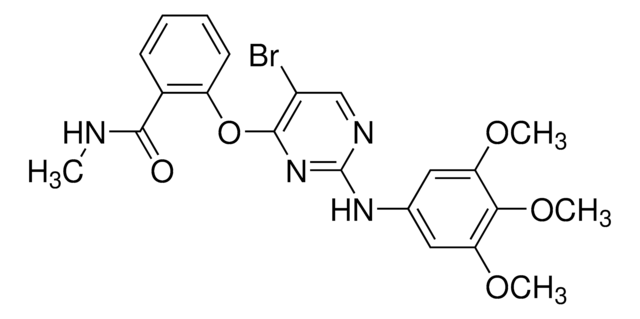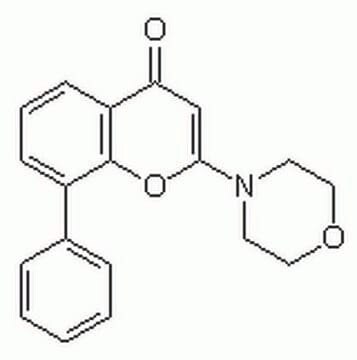681675
Wortmannin
≥98% (HPLC), solid, PI3-kinase inhibitor, Calbiochem
Sinónimos:
Wortmannin, KY 12420, MLCK Inhibitor II
About This Item
Productos recomendados
product name
Wortmannin, Wortmannin, CAS 19545-26-7, is a cell-permeable, potent, selective, and irreversible inhibitor of PI3-Kinase (IC₅₀ = 5 nM). Does not affect any upstream signaling events.
Quality Level
assay
≥98% (HPLC)
form
solid
manufacturer/tradename
Calbiochem®
storage condition
OK to freeze
protect from light
color
white to off-white
solubility
DMSO: 25 mg/mL
shipped in
ambient
Storage temp.
−20°C
InChI
1S/C23H24O8/c1-10(24)30-13-7-22(2)12(5-6-14(22)25)16-18(13)23(3)15(9-28-4)31-21(27)11-8-29-20(17(11)23)19(16)26/h8,12-13,15H,5-7,9H2,1-4H3/t12-,13+,15+,22-,23-/m0/s1
InChI key
QDLHCMPXEPAAMD-QAIWCSMKSA-N
General description
Biochem/physiol Actions
phosphatidylinositol-3-kinase
Packaging
Warning
Reconstitution
Other Notes
Nakamura, I., et al. 1995. FEBS Lett. 361, 79.
Ferby, I.M., et al. 1994. J. Biol. Chem. 269, 30485.
Okada, T., et al. 1994. J. Biol. Chem. 269, 3568.
Wymann, M.P. and Arcaro, A. 1994. Biochem. J.298, 517.
Arcaro, A. and Wymann, M.P. 1993. Biochem. J.296, 297.
Nakanishi, S., et al. 1992. J. Biol. Chem. 267, 2157.
Bonser, R.W., et al. 1991. Br. J. Pharmacol.103, 1237.
Legal Information
signalword
Danger
hcodes
Hazard Classifications
Acute Tox. 1 Inhalation - Acute Tox. 1 Oral - Acute Tox. 2 Dermal
Storage Class
6.1A - Combustible acute toxic Cat. 1 and 2 / very toxic hazardous materials
wgk_germany
WGK 3
flash_point_f
Not applicable
flash_point_c
Not applicable
Certificados de análisis (COA)
Busque Certificados de análisis (COA) introduciendo el número de lote del producto. Los números de lote se encuentran en la etiqueta del producto después de las palabras «Lot» o «Batch»
¿Ya tiene este producto?
Encuentre la documentación para los productos que ha comprado recientemente en la Biblioteca de documentos.
Los clientes también vieron
Nuestro equipo de científicos tiene experiencia en todas las áreas de investigación: Ciencias de la vida, Ciencia de los materiales, Síntesis química, Cromatografía, Analítica y muchas otras.
Póngase en contacto con el Servicio técnico















